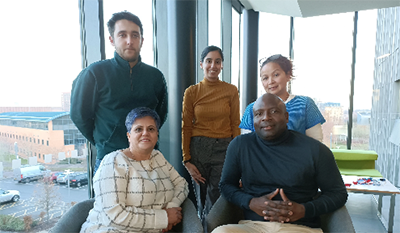You have no items in your shopping basket.
Clinical observations in special populations
Tailoring clinical observations for special populations in UK health and social care
Dr Richard Dune
07-03-2024
The one-size-fits-all approach must be revised in the diverse landscape of UK health and social care, especially regarding clinical observations across special populations. Paediatrics, geriatrics, and patients with disabilities present unique challenges that demand tailored approaches.
In this blog, Dr Richard Dune explores these challenges and offers insights into adapting clinical observation techniques to effectively meet the needs of these diverse groups.
Understanding the challenges
Paediatrics
Children are not just small adults. Their physiological parameters vary significantly as they grow, making standard adult-based clinical observations inadequate.
Key fact - The normal heart rate for a newborn can range from 120 to 160 beats per minute, a figure that would indicate tachycardia in an adult.
Geriatrics
Elderly patients often have multiple chronic conditions, which can complicate the interpretation of vital signs. For instance, what's considered 'normal' blood pressure in a younger adult may be a sign of hypotension in an older patient.
Statistic - Over 85% of adults aged 65 and over have at least one chronic condition, impacting the approach to clinical observations.
Patients with disabilities
Physical and cognitive disabilities can make standard clinical observation techniques challenging, requiring modifications for accurate assessment.

Image by skarie20 via Envato Elements

Image by AnnaStills via Envato Elements
Adapting clinical observation techniques
Paediatrics
- Use age-appropriate equipment, such as paediatric blood pressure cuffs.
- Incorporate play or storytelling to keep the child engaged and reduce anxiety during observations.
Geriatrics
- Consider the impact of comorbidities on vital signs.
- Be mindful of the effects of medications on physiological parameters.
Confidentiality
- Consider the impact of comorbidities on vital signs.
- Be mindful of the effects of medications on physiological parameters.
Disabilities
- For patients with physical disabilities, alternative sites for pulse and blood pressure measurements may be necessary.
- For patients with physical disabilities, alternative sites for pulse and blood pressure measurements may be necessary.
Case studies and best practices
Navigating the unique challenges of clinical observations in paediatrics, geriatrics, and patients with disabilities requires a deep understanding of their specific needs and innovative approaches and best practices. Here, we delve into detailed (anonymised) case studies and outline best practices that have significantly improved patient care in these special populations.

Image by DC_Studio via Envato Elements

Image by DC_Studio via Envato Elements
Case study - The playful approach in a paediatric ward
In a large UK hospital, the paediatric ward faced challenges with accurate clinical observations due to the anxiety and non-cooperation of young patients. The ward introduced an innovative approach by integrating play and storytelling into the observation process to address this. Child-friendly equipment was adorned with cartoon characters, and nurses were trained to explain procedures through storytelling, making the process less intimidating for children.
Results
There was a notable improvement in the accuracy of clinical observations, with a 40% reduction in the need for repeated measurements. Patient cooperation increased significantly, and the overall experience became more positive for children and their caregivers.
Best practice incorporating child-specific engagement techniques, such as using visually appealing equipment and integrating play, can significantly improve the accuracy and efficiency of clinical observations in paediatrics.
Case study - Comprehensive training for geriatric care
A geriatric unit within a UK care home developed a specialised training program for its nursing staff, focusing on interpreting clinical observations in the context of comorbidities and polypharmacy, common in elderly patients. The training emphasised understanding how chronic conditions and medications could alter vital signs, teaching nurses to discern between normal age-related changes and signs of acute deterioration.
- Results - The program led to a 30% decrease in unnecessary hospital admissions, as nurses became adept at recognising which changes in vital signs required intervention. Furthermore, there was enhanced patient management within the unit, improving patient outcomes and satisfaction.
- Best practice - Continuous professional development that includes training on the effects of comorbidities and medications on clinical observations is crucial in geriatric care. Understanding the nuances of ageing physiology can significantly enhance the quality of care for elderly patients.

Image by FabrikaPhoto via Envato Elements

Image by nuttapong_mohock via Envato Elements
Case study - Adaptive equipment in a specialised care facility
A specialised care facility for patients with physical and cognitive disabilities faced significant challenges in performing standard clinical observations. To address this, the facility invested in adaptive equipment, including blood pressure cuffs suitable for use on different parts of the body and communication aids to assist patients with cognitive impairments. Staff received training on using these tools and alternative communication strategies to involve patients actively in their care.
- Results - The use of adaptive equipment and tailored communication strategies led to more accurate clinical observations, with a 50% reduction in the need for external consultations for basic observational assessments. Patient engagement and satisfaction also saw a marked improvement.
- Best practice - Investing in adaptive equipment and training staff in tailored communication and observation techniques are critical in providing effective care for patients with disabilities. These practices ensure that all patients receive accurate and respectful care tailored to their specific needs.
Integrating best practices across special populations
Across all special populations, a few overarching best practices emerge:
- Person-centred care - Tailoring clinical observations and care plans to the individual's needs, preferences, and conditions.
- Multidisciplinary approach - Collaborating across disciplines to share insights and strategies for managing complex cases.
- Caregiver involvement - Engaging with caregivers as partners in care, particularly in paediatrics and disability care, to gain additional insights and support the patient's needs.
- Innovative solution - Exploring new technologies, methodologies, and equipment that can facilitate better clinical observations and patient care.

Image by dekddui1405 via Envato Elements

Image by stockfilmstudio via Envato Elements
Learning from case studies and best practice
These case studies illuminate the path forward in enhancing clinical observations for special populations within UK health and social care settings. By adopting patient-centred approaches, embracing innovation, and committing to continuous learning and adaptation, healthcare professionals can surmount the challenges posed by diverse patient needs, ensuring all individuals receive the highest standard of care. These practices improve clinical outcomes and enrich the caregiving experience, underscoring the profound impact of tailored care on patient well-being and satisfaction.
Tips for healthcare professionals
- Educate yourself - Continually update your knowledge on the specific needs and challenges.
- Use appropriate equipment - Invest in and utilise age and condition-appropriate equipment for clinical observations.
- Communicate effectively - Adapt your communication style to suit the patient's age, cognitive level, and any sensory impairments.
- Engage with caregivers - In paediatrics and certain disabilities, engaging with caregivers can provide additional insights and facilitate better care.
- Practice patience and empathy - Understanding and patience go a long way in building trust and cooperation from patients across all special populations.

Image by dekddui1405 via Envato Elements

Image by stockfilmstudio via Envato Elements
Conclusion
Clinical observations are a fundamental aspect of patient care in UK health and social care settings, but their effectiveness hinges on the ability to adapt to the unique needs of special populations. By understanding these needs, employing tailored techniques, and committing to continuous learning, healthcare professionals can ensure accurate, effective, and compassionate care for all patie
Enhance your skills in delivering tailored clinical observations across diverse patient groups. Explore our specialised training programs designed for healthcare professionals committed to excellence in care for paediatrics, geriatrics, and patients with disabilities. Enrol now and take the first step towards making a significant difference in the lives of special populations in UK health and social care.
The one-size-fits-all approach must be revised in the diverse landscape of UK health and social care, especially regarding clinical observations across special populations. Paediatrics, geriatrics, and patients with disabilities present unique challenges that demand tailored approaches.
In this blog, Dr Richard Dune explores these challenges and offers insights into adapting clinical observation techniques to effectively meet the needs of these diverse groups.
Understanding the challenges

Image by skarie20 via Envato Elements
Paediatrics
Children are not just small adults. Their physiological parameters vary significantly as they grow, making standard adult-based clinical observations inadequate.
Key fact - The normal heart rate for a newborn can range from 120 to 160 beats per minute, a figure that would indicate tachycardia in an adult.
Geriatrics
Elderly patients often have multiple chronic conditions, which can complicate the interpretation of vital signs. For instance, what's considered 'normal' blood pressure in a younger adult may be a sign of hypotension in an older patient.
Statistic - Over 85% of adults aged 65 and over have at least one chronic condition, impacting the approach to clinical observations.
Patients with disabilities
Physical and cognitive disabilities can make standard clinical observation techniques challenging, requiring modifications for accurate assessment.
Adapting clinical observation techniques

Image by AnnaStills via Envato Elements
Paediatrics
- Use age-appropriate equipment, such as paediatric blood pressure cuffs.
- Incorporate play or storytelling to keep the child engaged and reduce anxiety during observations.
Geriatrics
- Consider the impact of comorbidities on vital signs.
- Be mindful of the effects of medications on physiological parameters.
Confidentiality
- Consider the impact of comorbidities on vital signs.
- Be mindful of the effects of medications on physiological parameters.
Disabilities
- For patients with physical disabilities, alternative sites for pulse and blood pressure measurements may be necessary.
- For patients with physical disabilities, alternative sites for pulse and blood pressure measurements may be necessary.
Case studies and best practices

Image by DC_Studio via Envato Elements
Navigating the unique challenges of clinical observations in paediatrics, geriatrics, and patients with disabilities requires a deep understanding of their specific needs and innovative approaches and best practices. Here, we delve into detailed (anonymised) case studies and outline best practices that have significantly improved patient care in these special populations.
Case study - The playful approach in a paediatric ward

Image by DC_Studio via Envato Elements
In a large UK hospital, the paediatric ward faced challenges with accurate clinical observations due to the anxiety and non-cooperation of young patients. The ward introduced an innovative approach by integrating play and storytelling into the observation process to address this. Child-friendly equipment was adorned with cartoon characters, and nurses were trained to explain procedures through storytelling, making the process less intimidating for children.
Results
There was a notable improvement in the accuracy of clinical observations, with a 40% reduction in the need for repeated measurements. Patient cooperation increased significantly, and the overall experience became more positive for children and their caregivers.
Best Practice Incorporating child-specific engagement techniques, such as using visually appealing equipment and integrating play, can significantly improve the accuracy and efficiency of clinical observations in paediatrics.
Case study - Comprehensive training for geriatric care

Image by FabrikaPhoto via Envato Elements
A geriatric unit within a UK care home developed a specialised training program for its nursing staff, focusing on interpreting clinical observations in the context of comorbidities and polypharmacy, common in elderly patients. The training emphasised understanding how chronic conditions and medications could alter vital signs, teaching nurses to discern between normal age-related changes and signs of acute deterioration.
- Results - The program led to a 30% decrease in unnecessary hospital admissions, as nurses became adept at recognising which changes in vital signs required intervention. Furthermore, there was enhanced patient management within the unit, improving patient outcomes and satisfaction.
- Best practice - Continuous professional development that includes training on the effects of comorbidities and medications on clinical observations is crucial in geriatric care. Understanding the nuances of ageing physiology can significantly enhance the quality of care for elderly patients.
Case study - Adaptive equipment in a specialised care facility

Image by nuttapong_mohock via Envato Elements
A specialised care facility for patients with physical and cognitive disabilities faced significant challenges in performing standard clinical observations. To address this, the facility invested in adaptive equipment, including blood pressure cuffs suitable for use on different parts of the body and communication aids to assist patients with cognitive impairments. Staff received training on using these tools and alternative communication strategies to involve patients actively in their care.
- Results - The use of adaptive equipment and tailored communication strategies led to more accurate clinical observations, with a 50% reduction in the need for external consultations for basic observational assessments. Patient engagement and satisfaction also saw a marked improvement.
- Best practice - Investing in adaptive equipment and training staff in tailored communication and observation techniques are critical in providing effective care for patients with disabilities. These practices ensure that all patients receive accurate and respectful care tailored to their specific needs.
Integrating best practices across special populations

Image by dekddui1405 via Envato Elements
Across all special populations, a few overarching best practices emerge:
- Person-centred care - Tailoring clinical observations and care plans to the individual's needs, preferences, and conditions.
- Multidisciplinary approach - Collaborating across disciplines to share insights and strategies for managing complex cases.
- Caregiver involvement - Engaging with caregivers as partners in care, particularly in paediatrics and disability care, to gain additional insights and support the patient's needs.
- Innovative solution - Exploring new technologies, methodologies, and equipment that can facilitate better clinical observations and patient care.
Learning from case studies and best practice

Image by stockfilmstudio via Envato Elements
These case studies illuminate the path forward in enhancing clinical observations for special populations within UK health and social care settings. By adopting patient-centred approaches, embracing innovation, and committing to continuous learning and adaptation, healthcare professionals can surmount the challenges posed by diverse patient needs, ensuring all individuals receive the highest standard of care. These practices improve clinical outcomes and enrich the caregiving experience, underscoring the profound impact of tailored care on patient well-being and satisfaction.
Tips for healthcare professionals

Image by dekddui1405 via Envato Elements
- Educate yourself - Continually update your knowledge on the specific needs and challenges.
- Use appropriate equipment - Invest in and utilise age and condition-appropriate equipment for clinical observations.
- Communicate effectively - Adapt your communication style to suit the patient's age, cognitive level, and any sensory impairments.
- Engage with caregivers - In paediatrics and certain disabilities, engaging with caregivers can provide additional insights and facilitate better care.
- Practice patience and empathy - Understanding and patience go a long way in building trust and cooperation from patients across all special populations.
Conclusion

Image by stockfilmstudio via Envato Elements
Clinical observations are a fundamental aspect of patient care in UK health and social care settings, but their effectiveness hinges on the ability to adapt to the unique needs of special populations. By understanding these needs, employing tailored techniques, and committing to continuous learning, healthcare professionals can ensure accurate, effective, and compassionate care for all patie
Enhance your skills in delivering tailored clinical observations across diverse patient groups. Explore our specialised training programs designed for healthcare professionals committed to excellence in care for paediatrics, geriatrics, and patients with disabilities. Enrol now and take the first step towards making a significant difference in the lives of special populations in UK health and social care.
Related blog articles
View allRelated blog articles
View allReferences and resources
National Library of Medicine (2024) - 17 The Treatment of Special Populations: Conclusions and Recommendations - Broadening the Base of Treatment for Alcohol Problems - NCBI Bookshelf.
National Library of Medicine (2024) - 14 The Treatment of Special Populations: Overview and Definitions - Broadening the Base of Treatment for Alcohol Problems - NCBI Bookshelf.
Shropshire Community Health (2024) - Document Details Title Clinical Observations and recognition of the Deteriorating Patient Policy- including NEWS 2, PEWS, SBAR.
The Royal Children’s Hospital Melbourne (2024) - Nursing guidelines : Observation and continuous monitoring.


About The Mandatory Training Group
The Mandatory Training Group is one of the leading UK providers of CPDUK-accredited statutory and mandatory training, continuing professional development (CPD) courses, eLearning software and workforce development solutions for all sectors.
By making things simple and designing interactive e-learning content, we can provide meaningful training programs at all levels and enhance the capacity and resilience of individuals and organisations.
Click here to see our wide range of accredited clinical skills courses and training programmes.
References and resources

National Library of Medicine (2024) - 17 The Treatment of Special Populations: Conclusions and Recommendations - Broadening the Base of Treatment for Alcohol Problems - NCBI Bookshelf.
National Library of Medicine (2024) - 14 The Treatment of Special Populations: Overview and Definitions - Broadening the Base of Treatment for Alcohol Problems - NCBI Bookshelf.
Shropshire Community Health (2024) - Document Details Title Clinical Observations and recognition of the Deteriorating Patient Policy- including NEWS 2, PEWS, SBAR.
The Royal Children’s Hospital Melbourne (2024) - Nursing guidelines : Observation and continuous monitoring.
About The Mandatory Training Group

The Mandatory Training Group is one of the leading UK providers of CPDUK-accredited statutory and mandatory training, continuing professional development (CPD) courses, eLearning software and workforce development solutions for all sectors.
By making things simple and designing interactive e-learning content, we can provide meaningful training programs at all levels and enhance the capacity and resilience of individuals and organisations.
Click here to see our wide range of accredited clinical skills courses and training programmes.
Contact us
Complete the form below to start your ComplyPlus trial and transform your regulatory compliance solutions.







